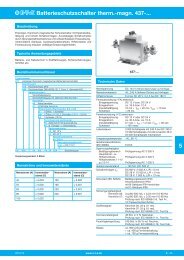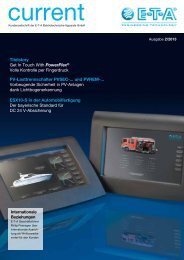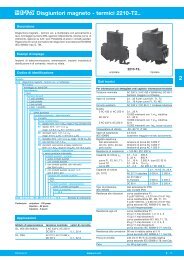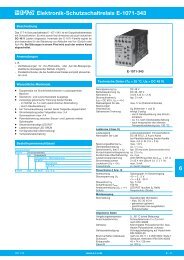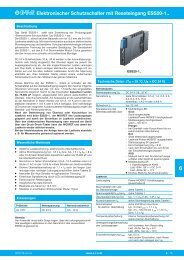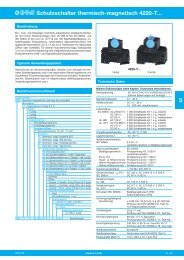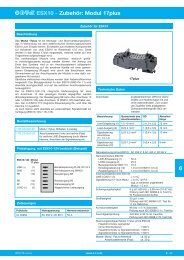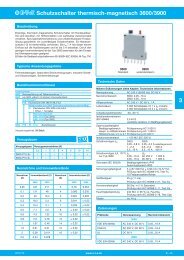Arc Fault Detector Type PVREM-â¦-AF1 / PVSEC-â¦-AF1 ... - ETA
Arc Fault Detector Type PVREM-â¦-AF1 / PVSEC-â¦-AF1 ... - ETA
Arc Fault Detector Type PVREM-â¦-AF1 / PVSEC-â¦-AF1 ... - ETA
Create successful ePaper yourself
Turn your PDF publications into a flip-book with our unique Google optimized e-Paper software.
<strong>Arc</strong> <strong>Fault</strong> <strong>Detector</strong><br />
<strong>Type</strong> <strong>PVREM</strong>-…-<strong>AF1</strong> / <strong>PVSEC</strong>-…-<strong>AF1</strong><br />
Preventive Fire Protection for Photovoltaic Systems<br />
<strong>PVREM</strong>-...-<strong>AF1</strong><br />
<strong>PVSEC</strong>-...-<strong>AF1</strong>
Technical information<br />
<strong>Arc</strong> <strong>Fault</strong> <strong>Detector</strong><br />
<strong>Type</strong> <strong>PVREM</strong>-…-<strong>AF1</strong> / <strong>PVSEC</strong>-…-<strong>AF1</strong><br />
<strong>Arc</strong> faults are a potential hazard in<br />
photovoltaic systems because of the high<br />
DC voltages and currents. <strong>Arc</strong> faults, mostly<br />
serial ones, are often caused by defective<br />
modules or connectors (plagiarism or<br />
copies) and by defective cables because of<br />
ageing, animal bite and hail. This may lead<br />
to fire in other components of the system<br />
and their surroundings, e.g. the roof.<br />
Technical data<br />
Features and benefits<br />
F_<strong>PVREM</strong>-<strong>AF1</strong>_<strong>PVSEC</strong>-<strong>AF1</strong>_e_310512A<br />
In order to realise an efficient preventive<br />
fire protection, E-T-A has designed several<br />
possible solutions which monitor the entire<br />
DC side of a photovoltaic system and thus<br />
help to enhance its safety and reliability.<br />
Serial arc will be detected, extinguished<br />
and indicated before any safety-critical<br />
situations can arise.<br />
Rated operational voltage max. DC 1,000 V<br />
Rated operational current max. 30 A<br />
Ambient temperature -30 °C...+66 °C<br />
Approval UL1699B, <strong>Type</strong> 1 Device<br />
Fail-safe-function integral<br />
<strong>PVSEC</strong>-...-<strong>AF1</strong>: Change-over auxiliarx contact<br />
5-pole terminal (spring-loaded) Supply voltage DC 24 V<br />
<strong>PVREM</strong>-...-<strong>AF1</strong>: Change-over auxiliarx contact<br />
8-pole terminal (spring-loaded) Supply voltage DC 24 V<br />
Three-position momentary switch (I-0-II)<br />
● Fire prevention through arc fault detection<br />
● Explicitly design for the photovoltaic market and its requirements<br />
● Two basic versions (detect, signal and disconnect):<br />
● One or two pole DC Disconnect with remote control and arc fault detection<br />
type <strong>PVREM</strong>-…-<strong>AF1</strong><br />
● One or two pole Firefighter Switch with arc fault detection type <strong>PVSEC</strong>-…-<strong>AF1</strong><br />
● Specified for various system configurations and power inverters<br />
● <strong>Arc</strong> fault detection (detect, distinguish between serial and parallel, signalling)<br />
is available as a customer-specific solution on pcb basis.<br />
Example of a customerspecific<br />
arc fault detection<br />
on pcb basis<br />
The arc fault detection feature is available in<br />
combination with the DC Disconnect with<br />
remote control and with the Firefighter<br />
Switch up to max. DC 1,000 V and 30 A.<br />
In addition we can provide a customerspecific<br />
version on printed circuit board<br />
basis.<br />
DC Disconnecti with remote control and arc fault<br />
detection type <strong>PVREM</strong>-…-<strong>AF1</strong><br />
Firefighter Switch with arc fault detection type<br />
<strong>PVSEC</strong>-…-<strong>AF1</strong><br />
E-T-A Elektrotechnische Apparate GmbH<br />
Industriestraße 2-8 . 90518 ALTDORF<br />
DEUTSCHLAND<br />
Phone: +49 9187 10-0 . Fax +49 9187 10-397<br />
E-Mail: info@e-t-a.de . www.e-t-a.de



